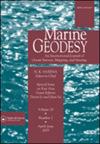Bathymetry Model in the Northwestern Pacific Ocean Predicted from Satellite Altimetric Vertical Gravity Gradient Anomalies and Ship-Board Depths
IF 1.4
4区 地球科学
Q2 GEOCHEMISTRY & GEOPHYSICS
引用次数: 4
Abstract
Abstract New bathymetry models in the northwestern Pacific Ocean are presented at 1 arc-minute and 15 arc-second resolution. The latest version of the altimetric vertical gravity gradient (VGG) anomalies from Scripps Institute of Oceanography, ∼7 million single-beam depths from the National Centers for Environmental Information, and ∼80 GB of multibeam grids from the Japan Agency for Marine-Earth Science and Technology are used. The ship-board depths are used to constrain bathymetry at wavelengths longer than 200 km, and calibrate the local topography to VGG ratio at 15–200 km wavelength bands. The VGG is used to predict bathymetry at 15 ∼ 200 km wavelength bands. The spectrum analysis results show that the 1 arc-minute model has more power than models predicted from gravity anomalies at wavelengths shorter than 100 km. The standard deviation of differences between the 1 arc-minute model and ship-board depths is 44.76 m, and it is 102.842 m comparing to the SIO topo_20.1.nc model. The accuracy of the new 1 arc-minute model has been improved significantly from our last bathymetry model, BAT_VGG, and has a better accuracy than that of the DTU18, GEBCO_08, and ETOPO1 models. The accuracy of the 15 arc-second model is consistent with that of SRTM + V2.1 and GEBCO_2020.利用卫星测高垂直重力梯度异常和船载深度预测西北太平洋测深模式
摘要提出了西北太平洋1角分和15角秒分辨率的新测深模型。使用了来自斯克里普斯海洋研究所的最新版本的高空垂直重力梯度(VGG)异常,来自国家环境信息中心的~ 700万单波束深度,以及来自日本海洋地球科学技术机构的~ 80gb多波束网格。船载深度用于约束波长超过200 km的水深测量,并在15-200 km波段校准当地地形与VGG的比率。VGG用于预测15 ~ 200 km波长波段的测深。光谱分析结果表明,1弧分模型比波长小于100 km的重力异常预测模型具有更高的功率。1弧分模型与船深差的标准差为44.76 m,与SIO topo_20.1相比差为102.842 m。数控模型。新的1弧分模型的精度比我们的上一个测深模型BAT_VGG有了明显的提高,并且比DTU18、GEBCO_08和ETOPO1模型的精度更高。15弧秒模型的精度与SRTM + V2.1和GEBCO_2020的精度一致。
本文章由计算机程序翻译,如有差异,请以英文原文为准。
求助全文
约1分钟内获得全文
求助全文
来源期刊

Marine Geodesy
地学-地球化学与地球物理
CiteScore
4.10
自引率
6.20%
发文量
27
审稿时长
>12 weeks
期刊介绍:
The aim of Marine Geodesy is to stimulate progress in ocean surveys, mapping, and remote sensing by promoting problem-oriented research in the marine and coastal environment.
The journal will consider articles on the following topics:
topography and mapping;
satellite altimetry;
bathymetry;
positioning;
precise navigation;
boundary demarcation and determination;
tsunamis;
plate/tectonics;
geoid determination;
hydrographic and oceanographic observations;
acoustics and space instrumentation;
ground truth;
system calibration and validation;
geographic information systems.
 求助内容:
求助内容: 应助结果提醒方式:
应助结果提醒方式:


